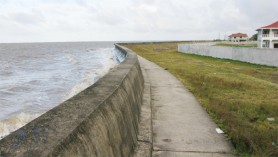Consumer Concerns
Three years ago house owners in the coastal region of Georgetown were warned not to engage in elaborate house repairs as the rising Atlantic Ocean would sweep away coastal houses 20 years on. The warning was given publicity in this column. However, no interest was shown in the topic, climate change. Houses were built, mortgages were given and life continued with serenity.

There have been warnings to rice farmers and cane growers, but no one seems to take climate change seriously. The Low Carbon Development Strategy (LCDS) seems to deal with the hinterland, the forest.
Complaints were made against the Sunday Lime along the Rupert Craig Highway in the vicinity of Sheriff Street. These complaints were intensified when, at a meeting at the Consumer Affairs division, Ministry of Tourism, Industry and Com-merce. It was disclosed that the Sunday tramping on the parapet was undermining the wall that protects us against the high seas. However, the Sunday Lime continues to this day undermining the wall and increasing the dangers of rising tides in climate change.
On the whole, we can say that there has been little interest in climate change, the melting icebergs, and the snow melting on mountain tops. We seem to be waiting for the developed world to act, and so there is no planting of mangrove or any action that would give some form of protection to our coastal areas.
In last Sunday Stabroek’s ‘Weekend Magazine,’ there is an article entitled ‘Coastal home owners face huge losses from rising sea.’ The Reuters article comes from Sydney. It describes the losses faced by Lesley and Doug McGrath:

* “Even with all that protection, the fury of the ocean has at times torn up their backyard, large chunks of prime real estate disappearing under waves. With scientists predicting 90 cm (3 feet) sea level rise in Sydney by 2050 due to climate change, the house itself may yet be in danger.”
* “Sea levels are widely expected to rise about one metre (3.3 feet) this century due to climate change, faster than the 18-59 cm (7-23 inches) outlined in a United Nations Climate Panel report in 2007.”
* “And coastal communities around the world are already feeling the destructive effects of more frequent and violent ocean storms, a pattern of rising seas.”
* “Other islanders tell stories of sitting and watching the ocean slowly devour their homes, and desperately trying to climate-proof their villages by constructing seawalls, planting mangroves to halt erosion and testing salt-resistant crops.”
So what do we do in Guyana? Wait for the developed world or think for ourselves?







